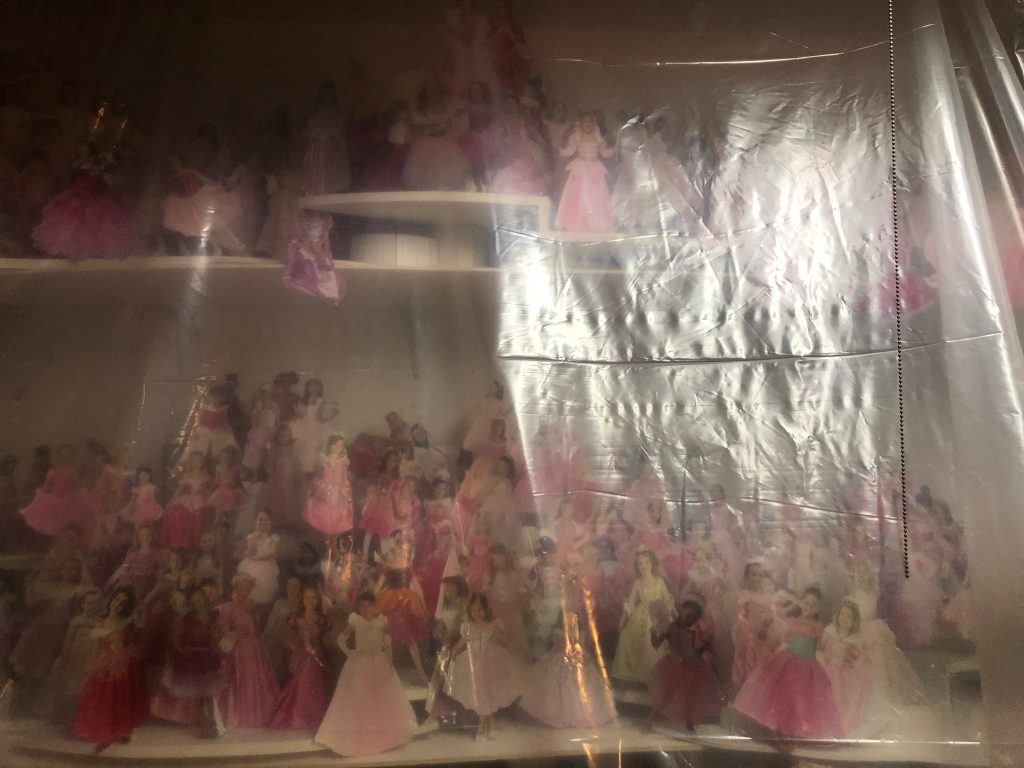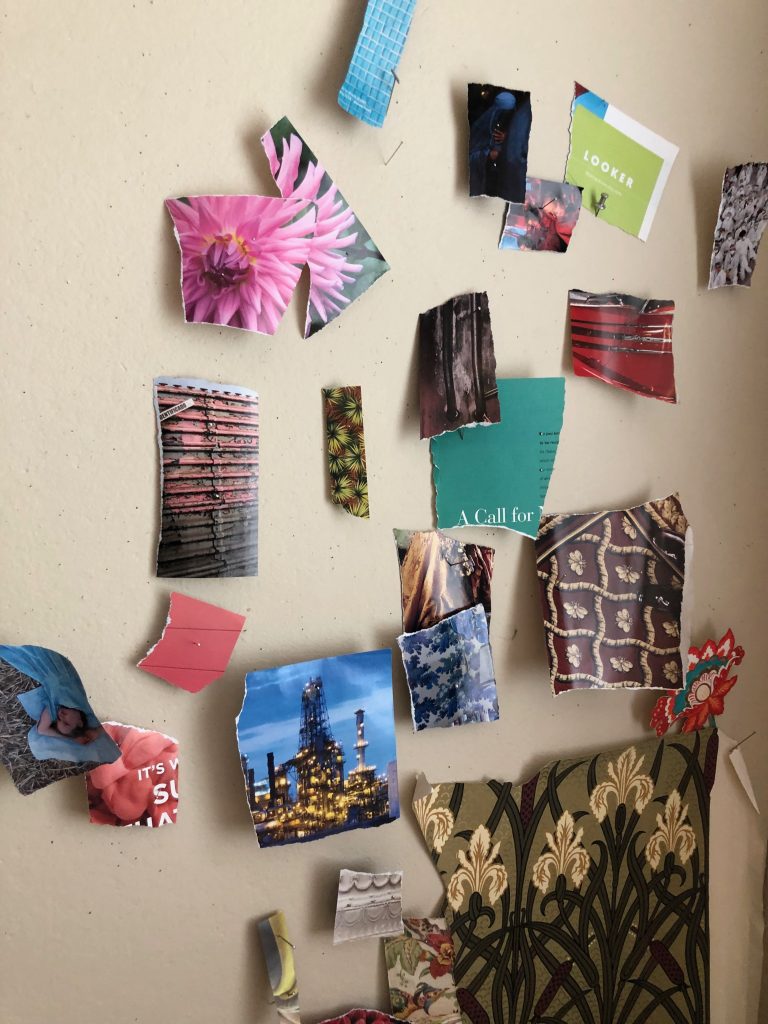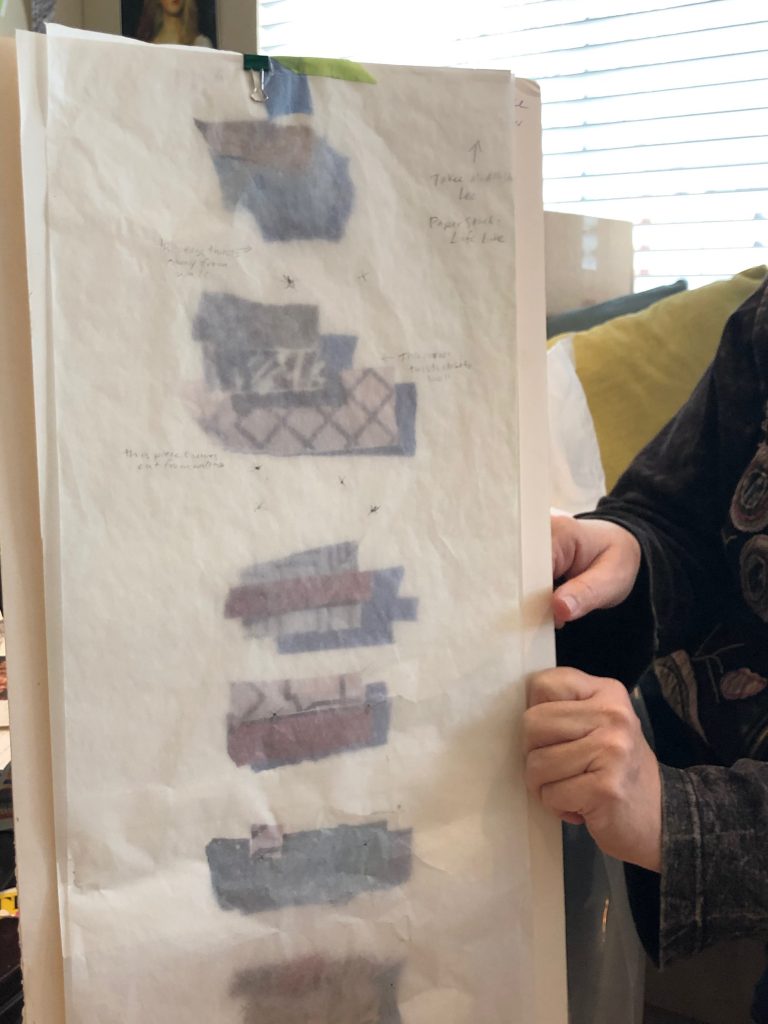TaVee’s Happy Hour Artist Talk was on Facebook Live on March 31st! Click here to see the interview.
TaVee McAllister Lee creates work that is both playful and haunting. Seeming to float down from the wall, fragments of photos are stacked, overlapped and clustered. TaVee is a keen curator, both in her role with Gearbox Exhibitions Committee and in her own studio practice. Sifting through huge stacks of magazines like Vanity Fair, National Geographic and South Dakota Magazine, TaVee tears images from these magazines and begins a deep dive into the world of juxtaposition. Her whole house contains work spaces for this creative process. In the family room are floor to ceiling walls of pin-friendly wall board–allowing her to explore visual relationships between image fragments. The dining room table is a cutting station for adding thin metal sheeting to the back of each photo. This metallic backing allows TaVee to bend and tilt the photos, and also casts a fascinating glow onto the wall behind the work. In her garage, artwork is glued, prepared for exhibition and archived.
For a great part of her process, it seems there’s a certain open-endedness that in her words “finally coalesces” into a finished work. It strikes me that TaVee’s work is about helping us notice overlooked relationships in visual culture. With a closer look, Tavee’s commentary about waste, income inequality and power dynamics begins to emerge.

On growing up:
I lived in Southeast Asia as a child, and I walked down the street seeing people hungry, in poverty in Laos. You may have been told to eat your vegetables because of the “starving children in India.” I was in a car in India with them running along outside grasping for coins or food through the windows. I saw children with bellies distended in starvation. My dad volunteered as an agricultural expert in Laos. We weren’t there as religious missionaries, we moved there initially as agricultural support with IVS, International Voluntary Service, similar to Peace Corps. Traveling to the States and back, we visited Japan, India, the Holy Land and parts of Europe. As a little girl I saw directly the wide disparity between peoples and cultures.
Eventually my dad went to work for Air America as the Secret War in Laos ramped up, ultimately making Laos the most heavily bombed country, per capita, in history. The juxtaposition of the beauty and warmth of the country, with my tangential experience of military coup and watching refugees walk down out of the hills for their rice rations was informative. The legacy of American bombing in Laos continues to this day while we go about our lives relatively unimpeded and wealthy, by world standards, here in America. I say this even as we are under a Shelter in Place Order during the Covid-19 episode.
As I entered first grade, my family moved from Laos to a placid and quintessentially American Way of Life in a college town in Oklahoma, complete with custom built home, congenial neighbors, playing in the creek, kids riding horses, family tv nights, and home cooked dinner on the table every night at 6 pm…

On her artistic process:
I deliberately set out to use materials that are essentially available to the average person. My primary photo source material is torn from magazines or, sometimes, advertising brochures. Other fragments are taken from consumer-available papers like wall paper or wrapping paper, even packaging. The term “paper fragments” is interesting because it implies that they are torn, already damaged, incomplete, likely destined for the landfill. On the other hand fragments can be precious, historical, preserved in museums and collections, a glimpse of another life and time.
To get ready for this show, I went through at least three four-foot tall magazine stacks to find source images. At first I just tear pages up, amassing piles of fragments, strewn on the flat surfaces of the studio or sorted into stacks of trays. Sorted is not quite the right word as it’s fairly haphazard. I notice images that intrigue me, they sort of emerge visually and I start pinning them to my “wall,” organizing or clustering them together. The pieces gradually find their way to each other as relationships form and build. I try not to think too much, I try to just be and let the fragments tell me where they want to go.
Part of the process is churning the paper that’s piled all around my studio before it goes on the wall. There’s a certain interesting thing that happens when I churn my images, I discover a relationship that comes forward that I didn’t intend. Sometimes its the thing on the back of an image that I tore so carefully.
Sometimes I get attached to one piece that’s ripped or torn, just so. I move it around from from stack to stack, to see if I can find a way to fit it in. It’s a delicate thing, I can’t just jam it in. I may pin it off to the side, hovering at the edge, waiting for its spot. If it doesn’t find a place for a while, say a few months, I will move it off the wall back to the churn pile to make room for new energy.
I tend to like stacked groups. I like the lift in the body as my head tilts up to see what’s above. I feel the impulse to open up the space, allowing the stack to drift or tilt. Eventually I have a feeling of satisfaction or completion as the fragments coalesce together in a place that holds some kind of open balance or harmony.
At that point I move an assembled grouping off the wall on to its own foam core backing and begin the detailed process of finishing the work. The individual components may be backed with a thin sheet of brass, aluminum or Bristol board. Possibly I’ll use color in the cast shadows. I consider where to insert the pins that hold the piece to the wall and how to choreograph the work with depth and tilt. I paint the heads of the pins, to elevate a sense of floating-ness and freeform expression.
My work is intended to last a while, certainly not hundreds of years, but I coat the paper with acid free UV coating providing some level of protection. Over time there will be some decay and color change.
These fragments tell me how they want to go together. I periodically move things into other stacks and see how I like them I tend to like space, but this current series is very clustered together.
If I’m doing a piece that’s very vertically tall, I test it out in my living room. I’m taking other peoples images, but they’re not really collages they are installations.

On her artwork’s content:
I’m always interested in what viewers experience after they’ve spent some time with my work, regardless of what that experience is. People who don’t understand my work often stand in front of it and, just listing off what they see, they end up creating a beautiful poem. I think of them as poems.
For me the work is about a specific sense of beauty. I’m taking something that is so NOT precious, picking pieces out of debris and carefully assembling them to create something made precious and beautiful in the face of, metaphorically speaking, separation, love, loss, random events, connection, hope and grief.
At the same time I’m making social commentary, and asking questions, but I prefer if that emerges a little obliquely and mysteriously, over time.
On one level the commentary is about the waste stream, consumerism and acquisition, on another it’s about social status, gender, power, achievement, need, desire. How do they intertwine? What is enough? What is valuable? What is meaningful? What is important?
One of my pieces is titled “Give Parties,” a directive from a magazine advertisement… Should we “Give Parties?” To what end? Is there something “better” we could be doing? People need connection, maybe a party is the thing? Maybe a Virtual Party?…. It’s a question… One of the beautiful images of the early days of Corona-virus in Italy is a courtyard of people singing together across the distance with a disco ball spinning light though the darkness… give parties…
Images in general deliver all kinds of ideas about what to want or have or be or how things are or how we think they are. Consumerism without thought drives world inequalities, poverty, and environmental damage. Who is benefiting? How do we experience the onslaught of visual information which may be even at odds with the text that accompanies it? Is the slice of advertisement for the diamond earrings, and by inference, the diamond earrings themselves, trash or treasure? That’s in there, those questions, underlying.
Additionally, magazine images themselves carry all kinds of other freight, tremendous resources have gone into delivering these slick or emotionally targeted and carefully curated images to us; the time it took to create the paper, the industry of the ink, the decisions of the editors, inclinations of photographers, the interest of the readers and then, to a great degree, all these ideas/images/shiny and beautiful, or fun, or intensely evocative, are intended to be fleeting, quickly replaced with the next issue, the next idea, as so much of the actual material expression of this endeavor goes on to the dump or, conversely, gets hoarded in stacks as tangible links to a coveted or desired world of adventure, safety, prowess, attainment, propaganda, knowledge and so forth, and Then it goes to the dump… probably … or possibly ultimately, when it becomes rare enough, to a museum…
In a way it’s all commentary, on our existence as beings on this earth, our decisions and our choices, how human beings gravitate to, against and away from each other, how we are in relationship, contained within the space and distance, how some things are so random while we strive to create a sense of stability, harmony or grace in the face of an ultimately Certain Outcome.
On the practical side, I’ve started to notice that the paper quality in magazines is getting to be so low, I wont be able to keep working the same way much longer.

On collaborating with Tamera Avery for their exhibition In the Wake:
I am very excited to show with Tamera Avery. First of all, the paintings are awesome. I’m very drawn to the imagery and scale. I enjoy the idea of the relationship of scale in our work, and what it means in the context of the work on its own and then how that might come forward in considering the work together in the space of the gallery.
I initially wanted to see our work together because we’re both figurative artists. There’s a further similarity in that we’re both concealing or obscuring a lot of the figure, especially faces, as part of the imagery. I’m curious about the psychological impact of that, what comes up for people as they consider it.
We have a surprisingly similar process, arranging appropriated images into an ultimately satisfying piece and then bringing that into “the real,” just in two really different directions.
I see both our work as emerging in the wake of so many shared societal impulses and overarching concerns, confronting a potentially bleak future, possibly, just maybe, holding out hope.
